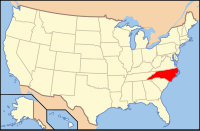Robeson County, North Carolina
| Robeson County, North Carolina | ||
|---|---|---|
|
||
 Location in the U.S. state of North Carolina |
||
 North Carolina's location in the U.S. |
||
| Founded | 1787 | |
| Named for | Colonel Thomas Robeson | |
| Seat | Lumberton | |
| Largest city | Lumberton | |
| Area | ||
| • Total | 951 sq mi (2,463 km2) | |
| • Land | 949 sq mi (2,458 km2) | |
| • Water | 1.8 sq mi (5 km2), 0.2% | |
| Population | ||
| • (2010) | 134,168 | |
| • Density | 141/sq mi (54/km²) | |
| Congressional districts | 7th, 8th | |
| Time zone | Eastern: UTC-5/-4 | |
| Website | www |
|
Robeson County is a county in the U.S. state of North Carolina. As of the 2010 census, the population was 134,168. Its county seat is Lumberton. The county was formed in 1787 from part of Bladen County. It was named in honor of Col. Thomas Robeson of Tar Heel, North Carolina, a hero of the Revolutionary War.
Robeson County comprises the Lumberton, NC Micropolitan Statistical Area, which is included in the Fayetteville-Lumberton-Laurinburg, NC Combined Statistical Area.
Robeson County has been one of the 10% of United States counties that were majority-minority; its combined population of American Indian, African American and Hispanic residents constitute more than 68 percent of the total. American Indians, mostly members of the state-recognized Lumbee Tribe of North Carolina, make up 38 percent of the population.
The University of North Carolina at Pembroke, a historically Native American college started as a normal school, is located in the county.
Archaeological excavation performed in Robeson County reveals widespread, continuous occupation of the region by various cultures of indigenous peoples since the end of the last Ice Age. They had camps and settlements near the Lumber River for its water, transportation, fish and related wildlife resources. Local excavations reveal that Native American peoples made stone tools, using materials brought to present-day Robeson County from the Carolina Piedmont. The large amounts of ancient pottery found at some Robeson County sites have been dated to the early Archaic Woodland period. Materials show that local settlements were part of an extensive Native American trade network with other regions. Portions of the river basin show that Robeson County was a "zone of cultural interactions."
...
Wikipedia

